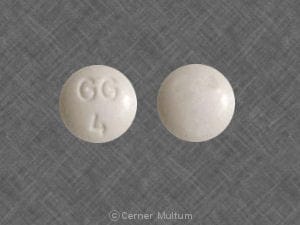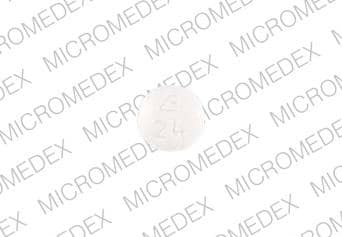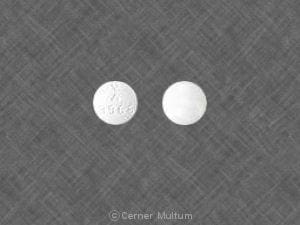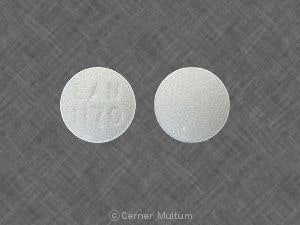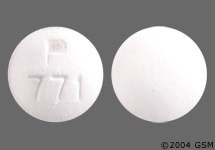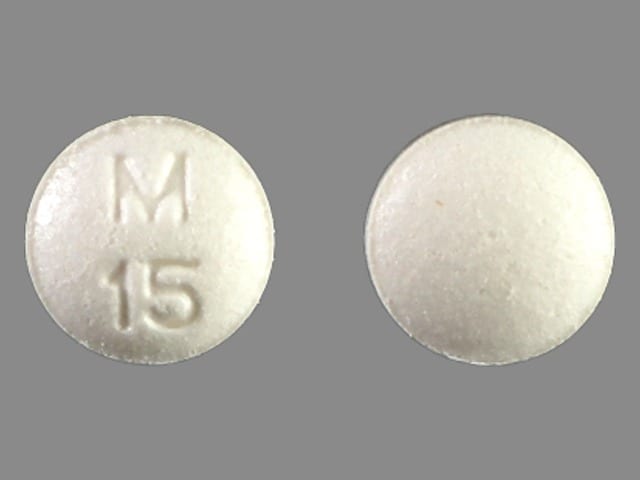Dosage Forms
Excipient information presented when available (limited, particularly for generics); consult specific product labeling.
Liquid, Oral:
Generic: Diphenoxylate hydrochloride 2.5 mg and atropine sulfate 0.025 mg per 5 mL (60 mL)
Tablet, Oral:
Lomotil: Diphenoxylate hydrochloride 2.5 mg and atropine sulfate 0.025 mg
Generic: Diphenoxylate hydrochloride 2.5 mg and atropine sulfate 0.025 mg
Pharmacology
Mechanism of Action
Diphenoxylate inhibits excessive GI motility and GI propulsion; commercial preparations contain a subtherapeutic amount of atropine to discourage abuse
Pharmacokinetics/Pharmacodynamics
Absorption
Diphenoxylate: Well absorbed
Metabolism
Diphenoxylate: Extensively hepatic via ester hydrolysis to diphenoxylic acid (active)
Excretion
Diphenoxylate: Primarily feces (49% as unchanged drug and metabolites); urine (~14%, [<1%] and metabolites)
Onset of Action
Within 45 to 60 minutes
Time to Peak
Diphenoxylate: Serum: ~2 hours
Half-Life Elimination
Diphenoxylate: 2.5 hours; Diphenoxylic acid: 12 to 14 hours
Use: Labeled Indications
Diarrhea, adjunct therapy: Adjunctive management of diarrhea in patients ≥13 years of age.
Contraindications
Hypersensitivity to diphenoxylate, atropine, or any component of the formulation; obstructive jaundice; diarrhea associated with pseudomembranous enterocolitis (Clostridioides [formerly Clostridium] difficile) or other enterotoxin-producing bacteria; pediatric patients <6 years of age (tablets only).
Canadian labeling: Additional contraindications (not in US labeling): Jaundice
Dosage and Administration
Dosing: Adult
Diarrhea, adjunct therapy: Oral: Note: Clinical improvement of acute diarrhea is usually observed within 48 hours. If clinical improvement is not seen within 10 days of dosing with the maximum dose, discontinue use.
Initial: Diphenoxylate 5 mg 4 times daily until control achieved (maximum: diphenoxylate 20 mg/day). Once control is achieved, reduce dose as needed; maintenance doses may be as low as 25% of initial daily dose required for control.
Dosing: Geriatric
Avoid use (Beers Criteria [AGS 2019]).
Dosing: Pediatric
Diarrhea, adjunct therapy: Note: Only the liquid product is recommended for use in children under 13 years of age; do not exceed recommended doses; reduce dose as soon as symptoms are initially controlled; maintenance doses may be as low as 25% of initial dose; if no improvement within 48 hours of therapy, diphenoxylate is not likely to be effective
Weight-directed dosing: Children 2 to 12 years: Oral: Liquid (2.5 mg diphenoxylate and 0.025 mg atropine per 5 mL): Initial: Diphenoxylate: 0.3 to 0.4 mg/kg/day in 4 divided doses, reduce dose as soon as symptoms controlled; maximum daily dose: 10 mg/day diphenoxylate
Age-directed fixed dosing:
Children ≥2 years: Oral: Liquid (2.5 mg diphenoxylate and 0.025 mg atropine per 5 mL):
2 years (11 to 14 kg): 1.5 to 3 mL 4 times daily
3 years (12 to 16 kg): 2 to 3 mL 4 times daily
4 years (14 to 20 kg): 2 to 4 mL 4 times daily
5 years (16 to 23 kg): 2.5 to 4.5 mL 4 times daily
6 to 8 years (17 to 32 kg): 2.5 to 5 mL 4 times daily
9 to <13 years (23 to 55 kg): 3.5 to 5 mL 4 times daily
Adolescents: Oral (liquid [2.5 mg diphenoxylate and 0.025 mg atropine per 5 mL] or tablets [2.5 mg diphenoxylate and 0.025 mg atropine per tablet]): Initial: Diphenoxylate: 5 mg 4 times daily until control achieved; maximum daily dose: 20 mg/day. Once control achieved, reduce dose as needed; maintenance doses may be as low as 25% of initial daily dose required for control.
Storage
Oral solution: Store at 20°C to 25°C (68°F to 77°F). Discard opened bottle after 90 days.
Tablet: Store at <25°C (<77°F).
Diphenoxylate and Atropine Images
Drug Interactions
Acetylcholinesterase Inhibitors: May diminish the therapeutic effect of Anticholinergic Agents. Anticholinergic Agents may diminish the therapeutic effect of Acetylcholinesterase Inhibitors. Monitor therapy
Aclidinium: May enhance the anticholinergic effect of Anticholinergic Agents. Avoid combination
Alcohol (Ethyl): CNS Depressants may enhance the CNS depressant effect of Alcohol (Ethyl). Monitor therapy
Alizapride: May enhance the CNS depressant effect of CNS Depressants. Monitor therapy
Amantadine: May enhance the anticholinergic effect of Anticholinergic Agents. Monitor therapy
Amezinium: Atropine (Systemic) may enhance the stimulatory effect of Amezinium. Monitor therapy
Anticholinergic Agents: May enhance the adverse/toxic effect of other Anticholinergic Agents. Monitor therapy
Azelastine (Nasal): CNS Depressants may enhance the CNS depressant effect of Azelastine (Nasal). Avoid combination
Blonanserin: CNS Depressants may enhance the CNS depressant effect of Blonanserin. Consider therapy modification
Botulinum Toxin-Containing Products: May enhance the anticholinergic effect of Anticholinergic Agents. Monitor therapy
Brexanolone: CNS Depressants may enhance the CNS depressant effect of Brexanolone. Monitor therapy
Brimonidine (Topical): May enhance the CNS depressant effect of CNS Depressants. Monitor therapy
Bromopride: May enhance the CNS depressant effect of CNS Depressants. Monitor therapy
Bromperidol: May enhance the CNS depressant effect of CNS Depressants. Avoid combination
Buprenorphine: CNS Depressants may enhance the CNS depressant effect of Buprenorphine. Management: Consider reduced doses of other CNS depressants, and avoiding such drugs in patients at high risk of buprenorphine overuse/self-injection. Initiate buprenorphine at lower doses in patients already receiving CNS depressants. Consider therapy modification
Cannabidiol: May enhance the CNS depressant effect of CNS Depressants. Monitor therapy
Cannabis: May enhance the CNS depressant effect of CNS Depressants. Monitor therapy
Chloral Betaine: May enhance the adverse/toxic effect of Anticholinergic Agents. Monitor therapy
Chlormethiazole: May enhance the CNS depressant effect of CNS Depressants. Management: Monitor closely for evidence of excessive CNS depression. The chlormethiazole labeling states that an appropriately reduced dose should be used if such a combination must be used. Consider therapy modification
Chlorphenesin Carbamate: May enhance the adverse/toxic effect of CNS Depressants. Monitor therapy
Cimetropium: Anticholinergic Agents may enhance the anticholinergic effect of Cimetropium. Avoid combination
CNS Depressants: May enhance the adverse/toxic effect of other CNS Depressants. Monitor therapy
Dimethindene (Topical): May enhance the CNS depressant effect of CNS Depressants. Monitor therapy
Doxylamine: May enhance the CNS depressant effect of CNS Depressants. Management: The manufacturer of Diclegis (doxylamine/pyridoxine), intended for use in pregnancy, specifically states that use with other CNS depressants is not recommended. Monitor therapy
Dronabinol: May enhance the CNS depressant effect of CNS Depressants. Monitor therapy
Droperidol: May enhance the CNS depressant effect of CNS Depressants. Management: Consider dose reductions of droperidol or of other CNS agents (eg, opioids, barbiturates) with concomitant use. Exceptions to this monograph are discussed in further detail in separate drug interaction monographs. Consider therapy modification
Eluxadoline: Anticholinergic Agents may enhance the constipating effect of Eluxadoline. Avoid combination
EPHEDrine (Systemic): Atropine (Systemic) may enhance the therapeutic effect of EPHEDrine (Systemic). Monitor therapy
Esketamine: May enhance the CNS depressant effect of CNS Depressants. Monitor therapy
Flunitrazepam: CNS Depressants may enhance the CNS depressant effect of Flunitrazepam. Consider therapy modification
Gastrointestinal Agents (Prokinetic): Anticholinergic Agents may diminish the therapeutic effect of Gastrointestinal Agents (Prokinetic). Monitor therapy
Glucagon: Anticholinergic Agents may enhance the adverse/toxic effect of Glucagon. Specifically, the risk of gastrointestinal adverse effects may be increased. Monitor therapy
Glycopyrrolate (Oral Inhalation): Anticholinergic Agents may enhance the anticholinergic effect of Glycopyrrolate (Oral Inhalation). Avoid combination
Glycopyrronium (Topical): May enhance the anticholinergic effect of Anticholinergic Agents. Avoid combination
HYDROcodone: CNS Depressants may enhance the CNS depressant effect of HYDROcodone. Management: Avoid concomitant use of hydrocodone and benzodiazepines or other CNS depressants when possible. These agents should only be combined if alternative treatment options are inadequate. If combined, limit the dosages and duration of each drug. Consider therapy modification
HydrOXYzine: May enhance the CNS depressant effect of CNS Depressants. Monitor therapy
Ipratropium (Oral Inhalation): May enhance the anticholinergic effect of Anticholinergic Agents. Avoid combination
Itopride: Anticholinergic Agents may diminish the therapeutic effect of Itopride. Monitor therapy
Kava Kava: May enhance the adverse/toxic effect of CNS Depressants. Monitor therapy
Lemborexant: May enhance the CNS depressant effect of CNS Depressants. Management: Dosage adjustments of lemborexant and of concomitant CNS depressants may be necessary when administered together because of potentially additive CNS depressant effects. Close monitoring for CNS depressant effects is necessary. Consider therapy modification
Levosulpiride: Anticholinergic Agents may diminish the therapeutic effect of Levosulpiride. Avoid combination
Lofexidine: May enhance the CNS depressant effect of CNS Depressants. Management: Drugs listed as exceptions to this monograph are discussed in further detail in separate drug interaction monographs. Monitor therapy
Macimorelin: Atropine (Systemic) may diminish the diagnostic effect of Macimorelin. Avoid combination
Magnesium Sulfate: May enhance the CNS depressant effect of CNS Depressants. Monitor therapy
Methotrimeprazine: CNS Depressants may enhance the CNS depressant effect of Methotrimeprazine. Methotrimeprazine may enhance the CNS depressant effect of CNS Depressants. Management: Reduce adult dose of CNS depressant agents by 50% with initiation of concomitant methotrimeprazine therapy. Further CNS depressant dosage adjustments should be initiated only after clinically effective methotrimeprazine dose is established. Consider therapy modification
MetyroSINE: CNS Depressants may enhance the sedative effect of MetyroSINE. Monitor therapy
Mianserin: May enhance the anticholinergic effect of Anticholinergic Agents. Monitor therapy
Minocycline (Systemic): May enhance the CNS depressant effect of CNS Depressants. Monitor therapy
Mirabegron: Anticholinergic Agents may enhance the adverse/toxic effect of Mirabegron. Monitor therapy
Monoamine Oxidase Inhibitors: Diphenoxylate may enhance the hypertensive effect of Monoamine Oxidase Inhibitors. Avoid combination
Nabilone: May enhance the CNS depressant effect of CNS Depressants. Monitor therapy
Nitroglycerin: Anticholinergic Agents may decrease the absorption of Nitroglycerin. Specifically, anticholinergic agents may decrease the dissolution of sublingual nitroglycerin tablets, possibly impairing or slowing nitroglycerin absorption. Monitor therapy
Opioid Agonists: CNS Depressants may enhance the CNS depressant effect of Opioid Agonists. Management: Avoid concomitant use of opioid agonists and benzodiazepines or other CNS depressants when possible. These agents should only be combined if alternative treatment options are inadequate. If combined, limit the dosages and duration of each drug. Consider therapy modification
Orphenadrine: CNS Depressants may enhance the CNS depressant effect of Orphenadrine. Avoid combination
Oxatomide: May enhance the anticholinergic effect of Anticholinergic Agents. Avoid combination
Oxomemazine: May enhance the CNS depressant effect of CNS Depressants. Avoid combination
OxyCODONE: CNS Depressants may enhance the CNS depressant effect of OxyCODONE. Management: Avoid concomitant use of oxycodone and benzodiazepines or other CNS depressants when possible. These agents should only be combined if alternative treatment options are inadequate. If combined, limit the dosages and duration of each drug. Consider therapy modification
Paraldehyde: CNS Depressants may enhance the CNS depressant effect of Paraldehyde. Avoid combination
Perampanel: May enhance the CNS depressant effect of CNS Depressants. Management: Patients taking perampanel with any other drug that has CNS depressant activities should avoid complex and high-risk activities, particularly those such as driving that require alertness and coordination, until they have experience using the combination. Consider therapy modification
Piribedil: CNS Depressants may enhance the CNS depressant effect of Piribedil. Monitor therapy
Potassium Chloride: Anticholinergic Agents may enhance the ulcerogenic effect of Potassium Chloride. Management: Patients on drugs with substantial anticholinergic effects should avoid using any solid oral dosage form of potassium chloride. Avoid combination
Potassium Citrate: Anticholinergic Agents may enhance the ulcerogenic effect of Potassium Citrate. Avoid combination
Pramipexole: CNS Depressants may enhance the sedative effect of Pramipexole. Monitor therapy
Pramlintide: May enhance the anticholinergic effect of Anticholinergic Agents. These effects are specific to the GI tract. Consider therapy modification
Ramosetron: Anticholinergic Agents may enhance the constipating effect of Ramosetron. Monitor therapy
Revefenacin: Anticholinergic Agents may enhance the anticholinergic effect of Revefenacin. Avoid combination
Ritodrine: Atropine (Systemic) may enhance the adverse/toxic effect of Ritodrine. Monitor therapy
ROPINIRole: CNS Depressants may enhance the sedative effect of ROPINIRole. Monitor therapy
Rotigotine: CNS Depressants may enhance the sedative effect of Rotigotine. Monitor therapy
Rufinamide: May enhance the adverse/toxic effect of CNS Depressants. Specifically, sleepiness and dizziness may be enhanced. Monitor therapy
Secretin: Anticholinergic Agents may diminish the therapeutic effect of Secretin. Management: Avoid concomitant use of anticholinergic agents and secretin. Discontinue anticholinergic agents at least 5 half-lives prior to administration of secretin. Consider therapy modification
Selective Serotonin Reuptake Inhibitors: CNS Depressants may enhance the adverse/toxic effect of Selective Serotonin Reuptake Inhibitors. Specifically, the risk of psychomotor impairment may be enhanced. Monitor therapy
Sincalide: Drugs that Affect Gallbladder Function may diminish the therapeutic effect of Sincalide. Management: Consider discontinuing drugs that may affect gallbladder motility prior to the use of sincalide to stimulate gallbladder contraction. Consider therapy modification
Sodium Oxybate: May enhance the CNS depressant effect of CNS Depressants. Management: Consider alternatives to combined use. When combined use is needed, consider minimizing doses of one or more drugs. Use of sodium oxybate with alcohol or sedative hypnotics is contraindicated. Consider therapy modification
Suvorexant: CNS Depressants may enhance the CNS depressant effect of Suvorexant. Management: Dose reduction of suvorexant and/or any other CNS depressant may be necessary. Use of suvorexant with alcohol is not recommended, and the use of suvorexant with any other drug to treat insomnia is not recommended. Consider therapy modification
Tapentadol: May enhance the CNS depressant effect of CNS Depressants. Management: Avoid concomitant use of tapentadol and benzodiazepines or other CNS depressants when possible. These agents should only be combined if alternative treatment options are inadequate. If combined, limit the dosages and duration of each drug. Consider therapy modification
Tetrahydrocannabinol: May enhance the CNS depressant effect of CNS Depressants. Monitor therapy
Tetrahydrocannabinol and Cannabidiol: May enhance the CNS depressant effect of CNS Depressants. Monitor therapy
Thalidomide: CNS Depressants may enhance the CNS depressant effect of Thalidomide. Avoid combination
Thiazide and Thiazide-Like Diuretics: Anticholinergic Agents may increase the serum concentration of Thiazide and Thiazide-Like Diuretics. Monitor therapy
Tiotropium: Anticholinergic Agents may enhance the anticholinergic effect of Tiotropium. Avoid combination
Topiramate: Anticholinergic Agents may enhance the adverse/toxic effect of Topiramate. Monitor therapy
Trimeprazine: May enhance the CNS depressant effect of CNS Depressants. Monitor therapy
Umeclidinium: May enhance the anticholinergic effect of Anticholinergic Agents. Avoid combination
Zolpidem: CNS Depressants may enhance the CNS depressant effect of Zolpidem. Management: Reduce the Intermezzo brand sublingual zolpidem adult dose to 1.75 mg for men who are also receiving other CNS depressants. No such dose change is recommended for women. Avoid use with other CNS depressants at bedtime; avoid use with alcohol. Consider therapy modification
Adverse Reactions
Frequency not defined.
Cardiovascular: Flushing, tachycardia
Central nervous system: Confusion, depression, dizziness, drowsiness, euphoria, hallucination, headache, hyperthermia, lethargy, malaise, numbness, restlessness, sedation
Dermatologic: Pruritus, urticaria, xeroderma
Gastrointestinal: Abdominal distress, anorexia, gingival swelling, nausea, pancreatitis, paralytic ileus, toxic megacolon, vomiting, xerostomia
Genitourinary: Urinary retention
Hypersensitivity: Anaphylaxis, angioedema
Warnings/Precautions
Concerns related to adverse effects:
- Atropinism: Use may cause atropinism (hyperthermia, tachycardia, urinary retention, flushing, dryness of the skin and mucous membranes), particularly in pediatric patients with Down syndrome. Monitor patients for signs of atropinism.
- CNS depression: May cause CNS depression, which may impair physical or mental abilities; patients must be cautioned about performing tasks that require mental alertness (eg, operating machinery or driving).
- GI effects: Use may slow GI motility and may enhance bacterial overgrowth and the release of bacterial exotoxins; has been reported to result in serious GI complications in patients with infectious diarrhea, including sepsis, prolonged and/or worsened diarrhea. Use is contraindicated in patients with diarrhea associated with organisms that penetrate the GI mucosa (toxigenic E. coli, Salmonella, Shigella), and pseudomembranous enterocolitis (Clostridioides [formerly Clostridium] difficile) associated with broad-spectrum antibiotics.
- Dehydration/electrolyte imbalance: In case of severe dehydration or electrolyte imbalance, withhold diphenoxylate/atropine treatment until corrective therapy has been initiated. Use in conjunction with fluid and electrolyte therapy when appropriate. Inhibiting peristalsis may lead to fluid retention in the intestine aggravating dehydration and electrolyte imbalance.
Disease-related concerns:
- Hepatic impairment: Use with caution in patients with hepatic impairment or advanced hepatorenal disease (hepatic coma may be precipitated).
- Renal impairment: Use with caution in patients with renal impairment or advanced hepatorenal disease.
- Ulcerative colitis: Use with caution in patients with acute ulcerative colitis; use may induce toxic megacolon. Monitor patients with acute ulcerative colitis carefully and discontinue promptly if abdominal distention occurs or if other untoward symptoms develop.
Concurrent drug therapy issues:
- Drug-drug interactions: Potentially significant interactions may exist, requiring dose or frequency adjustment, additional monitoring, and/or selection of alternative therapy. Consult drug interactions database for more detailed information.
Special populations:
- Pediatric: Cases of severe respiratory depression and coma, leading to permanent brain damage or death have been reported in patients <6 years of age. Use is contraindicated in children <6 years of age (tablets only).
Other warnings/precautions:
- Appropriate use: Do not exceed recommended dosage; overdose may result in severe respiratory depression, coma, and possible permanent brain damage or death. Clinical improvement of acute diarrhea is usually observed within 48 hours. If clinical improvement is not seen within 10 days of dosing with the maximum dose, discontinue use.
- Dependence: Physical and psychological dependence have been reported with higher than recommended dosing.
Monitoring Parameters
Number and consistency of stools; signs/symptoms of toxicity, fluid and electrolyte loss, hypotension, respiratory depression, and atropinism (dryness of skin and mucous membranes, tachycardia, thirst, flushing).
Pregnancy
Pregnancy Considerations
Animal reproduction studies have not been conducted with this combination. Refer to individual agents.
Patient Education
What is this drug used for?
- It is used to treat diarrhea.
Frequently reported side effects of this drug
- Nausea
- Dry skin
- Vomiting
- Lack of appetite
- Fatigue
- Dizziness
- Headache
Other side effects of this drug: Talk with your doctor right away if you have any of these signs of:
- Pancreatitis like severe abdominal pain, severe back pain, severe nausea, or vomiting.
- Seizures
- Dry mouth
- Difficulty breathing
- Slow breathing
- Shallow breathing
- Burning or numbness feeling
- Fast heartbeat
- Unable to pass urine
- Flushing
- Fast breathing
- Loss of strength and energy
- Sensing things that seem real but are not
- Enlarged pupils
- Miosis
- Mood changes
- Behavioral changes
- Vision changes
- Confusion
- Agitation
- Severe constipation
- Severe abdominal pain
- Abdominal edema
- Signs of a significant reaction like wheezing; chest tightness; fever; itching; bad cough; blue skin color; seizures; or swelling of face, lips, tongue, or throat.
Note: This is not a comprehensive list of all side effects. Talk to your doctor if you have questions.
Consumer Information Use and Disclaimer: This information should not be used to decide whether or not to take this medicine or any other medicine. Only the healthcare provider has the knowledge and training to decide which medicines are right for a specific patient. This information does not endorse any medicine as safe, effective, or approved for treating any patient or health condition. This is only a brief summary of general information about this medicine. It does NOT include all information about the possible uses, directions, warnings, precautions, interactions, adverse effects, or risks that may apply to this medicine. This information is not specific medical advice and does not replace information you receive from the healthcare provider. You must talk with the healthcare provider for complete information about the risks and benefits of using this medicine.
